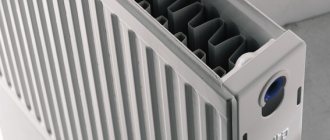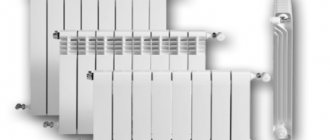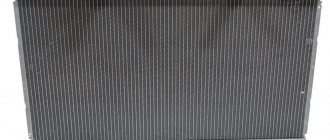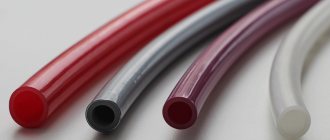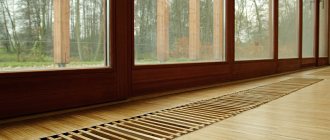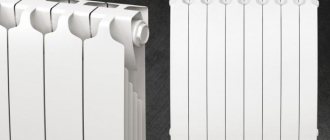Problem
The main problem that my relatives told me about was absolutely cold radiators in two adjacent rooms, while in other rooms the radiators got noticeably warmer with the beginning of the heating season.
- In rooms with warm batteries, the average daily temperature was + 17C;
- In rooms with inoperative heating + 13C.
As they say, feel the difference ...
For several days, calls from neighbors and relatives in the heating network ended in approximately the same way - nothing, because the house is cooperative, and its maintenance is not within their competence, except in emergencies.
And it was expensive for a cooperative of 60 apartments (4 entrances), where more than half of the residents are people of deep retirement age, to support their permanent plumbing from their own pockets. The part-time specialist only made sure that there were no leaks during system startup, and nothing more.
Searching of decisions
Arriving at the place, the first thing I do is check the taps on the radiators and bypasses - everything is open in both rooms. I open Mayevsky's taps on each radiator - a thin stream of water informs that there is pressure in the system, and the radiator is not air-conditioned. But you need to find out if there is a coolant in the system at all.
To this end, I go to the basement of the house. From the elevator unit I determine the direction and find "my" supply and return pipes.

This is our highway.
Having reached the location of the apartments in our entrance, I see two pipes - supply and return. To the touch, both pipes differ quite noticeably, so it was not difficult to determine that the colder one is the return.
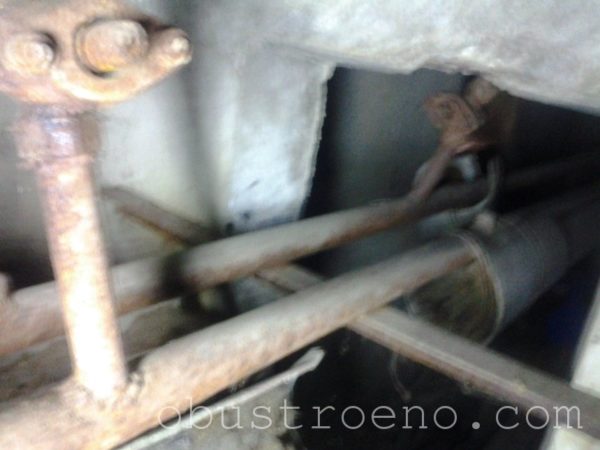

In the foreground is the return line.
Again I use my hands - both risers are cold, although literally a meter before this area the temperature was more than comfortable. The reason is the airing of the system on the upper fifth floor, which is why the coolant does not circulate.
I leave the basement and go to get acquainted with the neighbors of the upper floor, along the way asking other residents about the presence of stopcocks and their condition. As you'd expect, everyone has cast iron radiators installed 30 years ago.
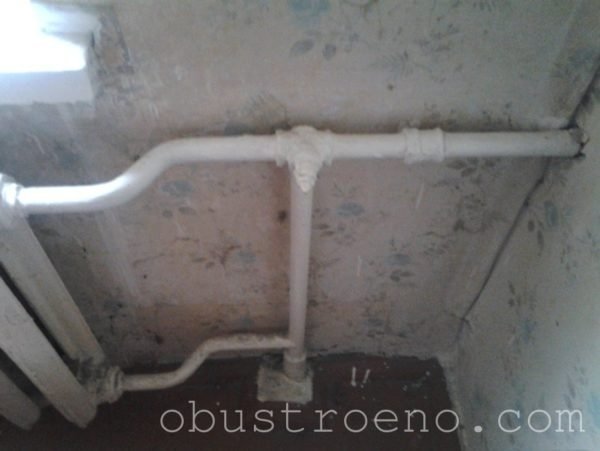

The fifth floor is a lintel between rooms.
In Khrushchev houses there is no technical floor, so the coolant is supplied from below from the basement. For clarity of the heating system, I propose to consider the diagram below.
Red arrows show the direction of movement from the feed, blue - the return.
We return to the apartment on the fifth floor. Cast iron radiators with 12 and 7 sections were installed in two rooms of the family of pensioners. It was them who were to be de-aerated.
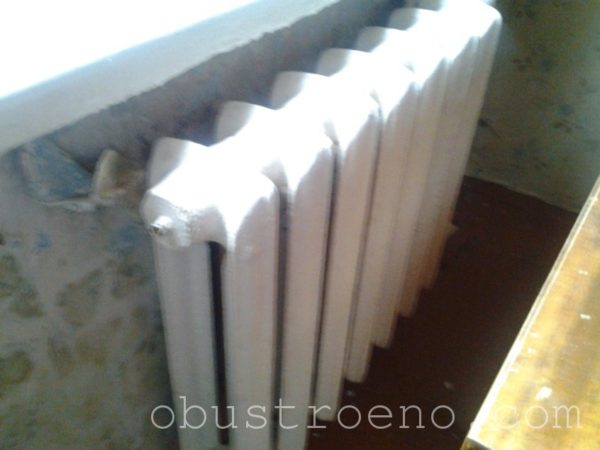

The reason for the lack of heat is in the accumulated air inside the radiator.
The only method available for this is with the help of a nipple (a prototype of the Mayevsky crane) embedded in the radiator cap.


Upcoming place of work.
- Old galvanized bucket for 12 liters;
- Pliers;
- Two flat-blade screwdrivers;
- A few doormats - splashes are inevitable.
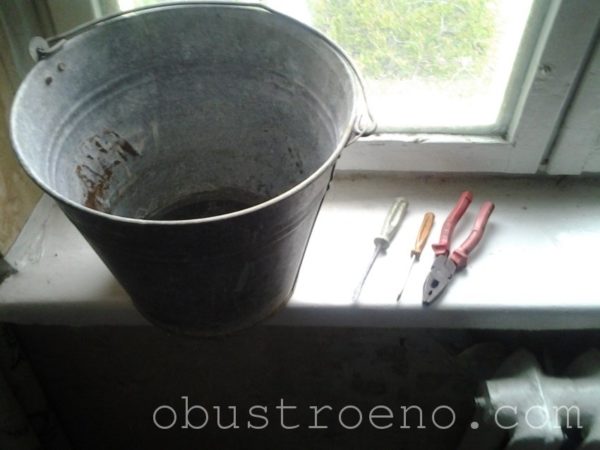

Here it is our simple tool.


I install a bucket under the radiator.
Since a lot of splashing is expected, I provide a place around the radiator to work - I remove the flower pots and move the furniture away
Then I take a screwdriver and carefully, so as not to lick off the edges, unscrew the screw counterclockwise
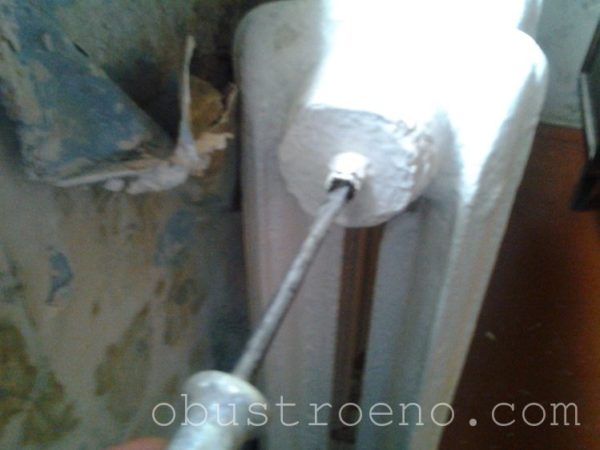

Excessive efforts have to be made.
- The old system did not give in on the first attempt, I had to use the pliers - with their help I turned the screwdriver until the screw was removed from the stuck place;
- A hiss of air marked the beginning of an airlock. Within 3-4 minutes the air left the radiator, after which cold water flowed in a thin stream;
- By adjusting the screw so that water flowed into the bucket that was placed, I gave time - in about half an hour, when the bucket was half full, the water temperature changed from ice to warm, after which I screwed the screw back.
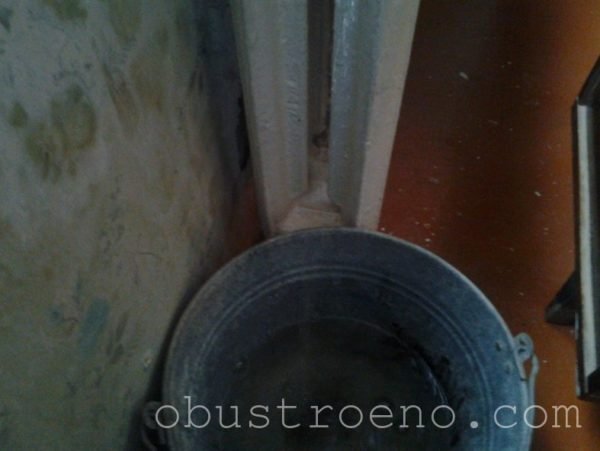

How not to remember the classics: "Oh, lukewarm went ...."
I did the same operation with a cast-iron battery in another room. A few hours later, it became noticeably warmer in the apartments - the thermometer showed a rise of a couple of degrees. Of course, there is no need to talk about a complete solution to the problem of cold in the apartment, because the temperature of the coolant is far from 75C, but outside the window is not yet a fierce winter.
I hope that my experience will be useful to some of you. If the symptoms are similar, negotiate with the neighbors of the upper floor and air the riser before winter sets in. Good luck comrades!
How to hide heating pipes in the bathroom
The bathroom differs from all other rooms in high humidity. This will be the feature: you need to use materials that are not afraid of moisture. The solutions here are, in principle, the same: hide in the wall or make a box for them. Naturally, pipes must be laid in the wall before laying the tiles, but the box can be built after.
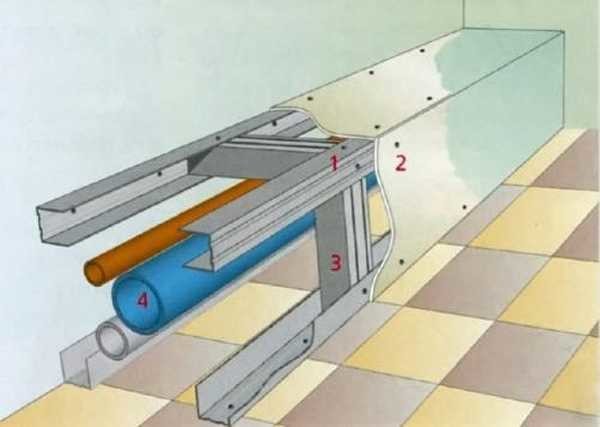

How to hide heating pipes in a bathroom


Hiding the heating pipes under the baseboard is one of the ways to get by with "little blood"
The principle of construction is no different: you make a frame, and then sheathe it. But the difference will be in the materials. You need to use galvanized profiles, and drywall is moisture resistant. Even taking into account the fact that you will stick the tiles on top. The tile will most likely have to be cut to fit the frame format (or the frame size should be made taking into account the tile size), and the corners and cuts can be closed with special corners to match the tile, contrasting color, white, etc. - the choice depends on your desire and bathroom design.
One of the panels of the box can be made removable. It can be held on magnets, corners, stops. This will not violate the aesthetics and will provide access to communications.
There is an option that, if appropriate, will allow you to get off with "little blood": there are special plastic baseboards-boxes. So if the heating pipes in a bathroom or another room run along the wall above the floor itself, you can hide them in such a baseboard.
If none of these methods suit you for some reason, you can try to decorate them.
The principle of building a heating system
Speaking about the principle of operation of the heating scheme for multi-storey buildings, a few words should be said about its construction. It's actually pretty simple. Most modern homes use a one-pipe centralized heating system for a five-story house or one with fewer / more stories. That is, the heating scheme of a 5-storey building is a single (for one entrance) riser, in which the coolant can be supplied both from below and from above.
In accordance with the location of the supply element, there are also two types of directionality of the coolant. So, provided that the supply pipes are located in the basement, there is a counter movement of the coolant. And if the supply element is in the attic, then the passing direction.
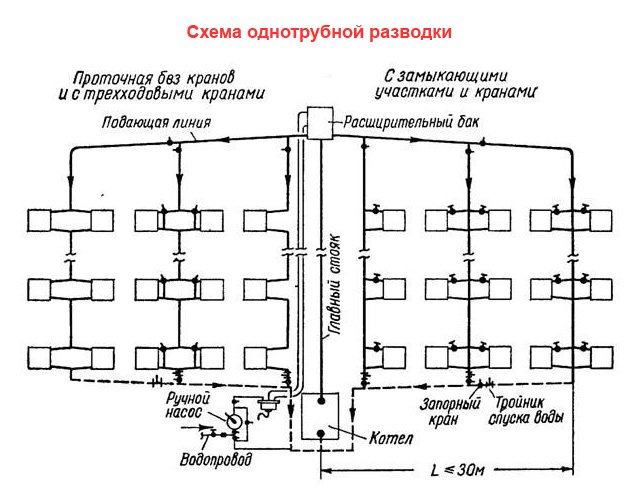

Many are interested in how the radiator area is determined for a particular room. In fact, everything is quite simple - you just need to take into account the cooling rate of the used coolant (water).
Most of us mistakenly believe that the higher the house, the more complicated and confusing is the heating scheme of a multi-storey building. But this is a wrong opinion.In fact, the number of apartments that need to be heated mainly affects the calculation of heating in an apartment building.
1. 2. 3. 4. 5.
An apartment in a multi-storey building is an urban alternative to private houses, and a very large number of people live in apartments. The popularity of city apartments is not strange, because they have everything that a person needs for a comfortable stay: heating, sewerage and hot water supply. And if the last two points do not need special introduction, then the heating scheme of a multi-storey building requires detailed consideration. From the point of view of design features, the centralized one has a number of differences from autonomous structures, which allows it to provide the house with thermal energy in the cold season.
Video: how heating is served in an apartment building
A city apartment is a center of comfort and coziness, a place to live, which is chosen by many of our compatriots. Indeed, in a modern apartment building there is everything that a person needs for a normal life, from hot water supply to centralized heating and sewerage.
It should be noted that the heating system plays a huge role in ensuring a comfortable atmosphere in the apartment. At present, the scheme of the heating system of a multi-storey building has some structural differences from an autonomous one, and it is they who guarantee effective heating of an apartment even in the most severe frosts.
How to hide heating pipes in a private house by decorating
Hiding pipes in a wall or box significantly reduces the heat transfer of heating elements. Sometimes these activities are contraindicated. That is why pipe decor is widely used to close communications.
In this version, you can safely listen to your imagination. The main thing is that the original effect fits harmoniously into the interior of the room. You can simply paint the pipes to match the color scheme of the room.
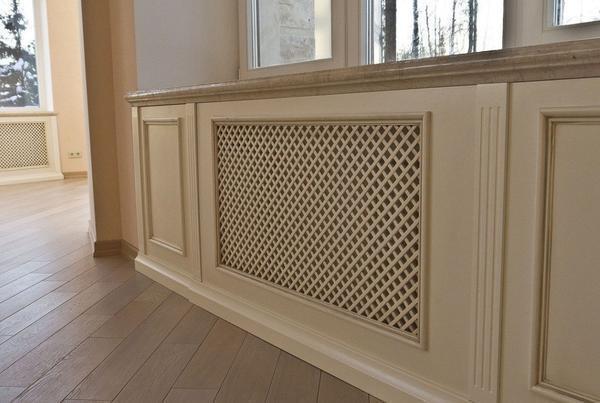

Requirements for paints:
- Mechanical durability;
- Thermal strength;
- Non-toxic.
Jute or hemp rope can be used as a decor. But this will reduce the heat transfer of the pipes. You can also try split bamboo. You can additionally decorate with branches and leaves, creating a branch. Highly placed pipes can be closed with curtains.
For staining communications, water-dispersion, acrylic or alkyd enamel is used.
It is easier to hide pipes at the stage of laying communications. Then it becomes possible to mount the system as discreetly as possible. Also, in this case, it becomes possible to make a warm floor.
How to hide heating pipes in an apartment using a box
The box is considered a good option when the heating system is already installed. You can sheathe the casing with plastic, drywall, wood. Before work, you should make sure the integrity of the communications.
Required tools for installation:
- Metal profile;
- Self-tapping screws with dowels;
- Material for the box;
- Screwdriver;
- Drill;
- Scissors for metal.
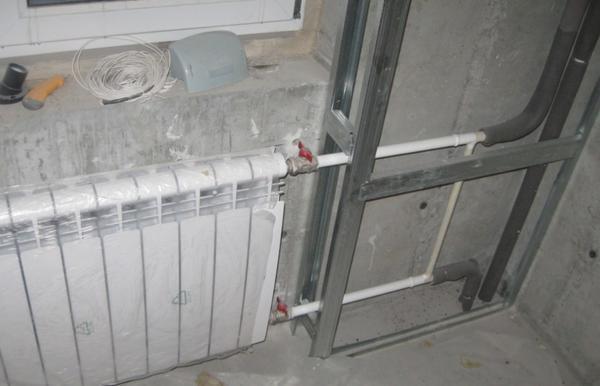

First you need to make the frame of the box. The material of manufacture is fixed with self-tapping screws. First, the markup of the location of the communications is carried out. Take into account the dimensions of the pipes, the thickness of the material and the interval between the walls of the box and communications.
Do not install pipes close to the box. It is optimal to leave a distance of 3 cm.
Further building profiles are installed. Then the guides are fixed. To fasten the profiles together, cutters are used.
Then the corner profiles are mounted. If the spacing between the posts exceeds 25 cm, then additional jumpers should be made. If the height of the racks is more than 150 cm, then horizontal jumpers are mounted. When the frame is ready, they begin to design it. Bevels are removed from drywall before installation.But if in the future tiling is envisaged, then this process can be omitted.
They begin to install the walls of the box from the side parts and move towards the central ones. After installing the walls, the box must be decorated decoratively. To do this, use tiles, wallpaper, paint.
If you want to hide the batteries, you can build a false wall. The execution technology is similar to the box. First, the frame is made, then the walls are sheathed. A significant disadvantage of this decoration method is the reduction in the area of the room. If you don't want to bother with installing these elements, then you can purchase a ready-made box in a hardware store.
Initial treatment of the wall behind the battery
In the picture above, you can clearly see that the wall behind the battery has not been processed. If this is the first time you remove the battery, then most likely there will be not a white, but a gray dusty wall with old stubborn paint. It is clear that you cannot immediately glue the wallpaper on such a wall. If you decided not to glue the wallpaper, but to make the wall cladding a decorative panel, as can be clearly seen in the pictures in the article, then in any case, the wall needs to be processed at least in order to remove the smells of old walls and old repairs (advice from my personal experience ).
So where do you start? We begin to beat off the extra bumps on the wall, the remnants of old putty and paint with a hammer and chisel. Especially we pass in those places where the plinth should be attached to us. Planned time about 1 hour:


Then it is imperative to remove all debris and prime the wall (see section).
We prime the wall 2 times. The priming itself takes 10 minutes, but the drying time for each of the layers is 1.5 hours.
Total: cleaning + wall primer + drying time is about 4 hours.
Design features of the heating circuit


In modern buildings, additional elements are often used, such as collectors, heat meters for batteries and other equipment. In recent years, almost every heating system in high-rise buildings has been equipped with automation in order to minimize human intervention in the work of the structure (read: "Weather-dependent automation of heating systems - about automation and controllers for boilers by examples"). All the details described allow you to achieve better performance, increase efficiency and make it possible to more evenly distribute heat energy across all apartments.
Centralized heating scheme for Khrushchev
The houses of this project are characterized by a one-pipe scheme, when the distribution of the coolant starts from the upper (5th) floor and ends with the entrance of cooled water into the basement. Such heating systems in Khrushchev have one significant drawback - the uneven distribution of heat throughout the apartments.
This is due to the alternate passage of the coolant through the floors, i.e. the highest degree of its heating will be at the 5th, 4th, and at the 1st, the amount of heat is insufficient to heat the room. In addition, the heating scheme of the five-story Khrushchev has the following disadvantages:
- Poor condition of heating elements. Lime build-up on the inner surface of pipes and batteries leads to a decrease in diameter, and as a result, a decrease in heat transfer;
- Lack of temperature control system on batteries. Reducing the flow of coolant with devices is impossible, since this will affect the hydraulic pressure in the entire system. Output - installation of a bypass for each radiator.
To solve these problems, it is necessary to carry out modernization - to install modern radiators and pipes. Metallic heating devices and polymer pipelines have proven themselves best. They have increased heat transfer rates, which contributes to the fastest heating of rooms. However, in order to create a truly efficient heating system in Khrushchev, it is necessary to replace all floors. If old pipes and radiators are left on the upper ones, then the rate of passage of water in the system will be unsatisfactory.
The implementation of such modernization can be carried out not only by the forces of residents, but also by attracting the resources of the housing office. This organization is obliged to carry out a planned replacement of pipelines. They also know how the heating system in Khrushchev works - the diagram and location of pipelines for a particular house.
Battery replacement options
- The batteries with pipes are built into the façade walls.
Most likely, any work in this case will be strictly prohibited. Indeed, the design of the building includes heat from these pipes along the facade. And any individual changes are simply unacceptable. The only solution would be to order an alteration of the heating system throughout the house with insulation of the outer walls. It will be necessary to break through the floors, equip the risers and only then connect new radiators to them.
- Piping in inner plates.
There are serious restrictions on load-bearing walls. As a rule, it was in them that the batteries were embedded. And any demolitions or penetrations are not allowed. The only thing that can be done is to find “embedded” in the corners of the slabs. These are such pockets in concrete, where the slabs and heating pipes were connected to each other. These places are easy to find by tapping. After connecting the pipes, the voids were filled with a solution that sounds very different from factory concrete. Then the coil in the wall is tightly closed and a new radiator with a bypass is inserted.
- The batteries are inside, but there are riser bends outside.
In some series of houses, although the radiators are also in the walls, bends of pipes can be seen in the corners of the rooms. Everything is much simpler here. Getting close to them and crashing into the system will not be difficult. In addition, you do not have to make a project and go through lengthy approvals.


Whatever the situation, you need to clearly understand that the battery embedded in the wall is in fact a common riser of the entire entrance. And any changes on it affect the quality of heating for all neighbors above and below. Whatever is done, the riser must not be blocked or narrowed.
Only a specialist can accurately determine the series of the house and the configuration of the pipes inside the panels. It will be necessary to bring up the documents of Soviet projects. It will only be possible to independently find by touch where such a battery is located.
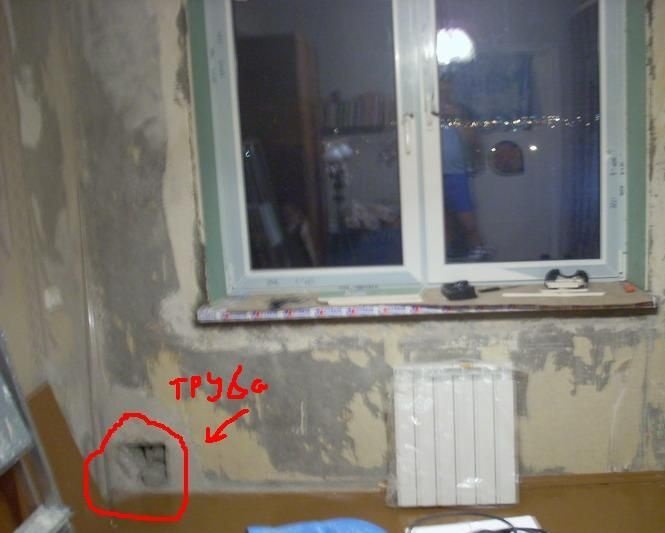

All these works will cost a lot of money. And heat problems can be completely different.
Before "removing" the batteries from the walls, it is worth contacting the house management company and demanding to identify the reasons for the lack of heat in the rooms. Perhaps an air lock has simply formed in the embedded pipes or there are defects in the sealing of the seams. Or from time to time the insulation inside the panels simply decayed. In many cases, they will fix problems without reworking the heating system, or will be forced to install an external battery for free.
Panel heating systems
In panel heating systems, heating devices are steel pipes through which the coolant passes; the pipes are embedded in concrete panels. By combining elements of heating systems with building structures, the prefabrication of construction increased and labor costs were reduced. In addition, the sanitary-hygienic and aesthetic qualities have increased, as well as the metal consumption has decreased in comparison with heating systems in which radiators are the heating devices.
Fig. 1. Sill concrete heating panels: 1 - slab, 2 - coil, 3 - double adjustment tap, 4 - hatch, 5 - groove, 6 - heating riser, 7 - seams around the perimeter of the panel, 8 - sleeve, 9 - slag layer, 10 - floor, 11 - floor slab
When installing a panel heating, the heating element is placed: in attached window-sill panels, partitions, external walls, and also embedded in the ceiling or in the floor.
Heating panels are a complete prefabricated element, and their installation is carried out simultaneously with the construction of the building.
Window panel (Fig.1) is a slab of concrete grade 200-250, into which a coil of pipes with a diameter of 20 mm is monolithic. For thermal insulation of the panel from the outer wall, an insulating layer of slag wool with a thickness of 30-40 mm is laid between the panel wall and the outer wall. It is possible not to use an insulating layer, but in this case it is necessary to leave an air gap of 40-50 mm between the inner surface of the panel and the outer wall.
The panels are installed directly on the floor slab and attached to the outer wall.
Under-window heating panels are not widely used due to the complexity of their installation, as well as the need for additional laying of risers and connections.
Partition heating panels are used much more widely (Fig. 2). In these panels, not only heating elements, but also risers are monolithic, therefore, the installation of the system is reduced to installing the panels, connecting them with interfloor inserts and laying main pipelines.
The partition panel is a concrete slab 120 mm thick, 800-1000 mm wide and one floor high. The panel is part of the partition and is installed near the outer wall.


Fig. 2. Partition heating panels: a - for a two-pipe system, b - for a one-pipe system; 1 - heating elements, 2 - concrete panel, 3 - control valve
Partition heating panels can be used in two-pipe and one-pipe heating systems.
The disadvantages of partition panels are: equal heat transfer to two adjacent rooms with different heat losses and the inability to adjust the heat supply to each room, the difficulty of processing the interface between the panels and partitions (cracks), the absence of taps for household adjustment and a large concentrated heat transfer of the panel.
To reduce the concentrated heat transfer, heating elements are placed along the perimeter of the partition (Fig. 3).


Fig. 3. Partition concrete heating panels: a - riser diagram of a single-pipe panel heating system, b - partition heating panel of R-2 type, c - the same, R-4, d - the same, R-1, e - the same, R -3
Currently, the most rational are panel heating systems, in which heating elements and risers are embedded in external wall panels (Fig. 4).
In such systems, the number of cold surfaces in the room is reduced, and when the heater is located in the lower part of the outer wall under the windows, the effect of falling cold air flows from the windows is eliminated and the possibility of room-by-room temperature control is provided.
Fig. 4. Wall panel with heating element
Heating panels are tested at the factory with a hydraulic pressure of 10 kgf / cm2. The panel is considered suitable for installation if no pressure drop is observed within 5 minutes.
In panel houses, heating pipes are often built into the wall. When moving to a building of this type, people are often surprised at such an arrangement of heating elements and even doubt their effectiveness. How efficient is such a system? Will the apartment be warm enough during the cold season? Let's try to answer these questions.
Heating system wiring diagram
When placing heating devices inside a room or during repair work, the question often arises about the pipe routing scheme. Standard schemes: beech P or inverted beech W. Which of their schemes is implemented in your apartment depends on the panel house.
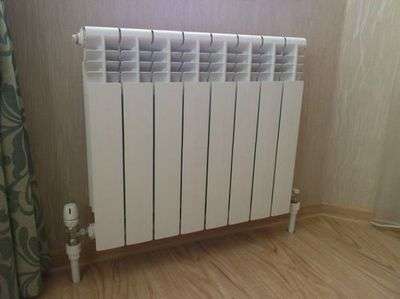

Two risers are located next to each other. Sometimes they are separated by a wall that separates the rooms. In this case, the riser looks like a letter T, 2 risers are located on one side and one on the other. They pass through the walls. Conclusion of zones of connection of structures - ceiling and floor.
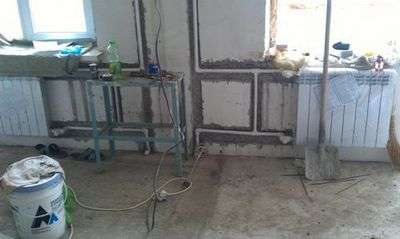

Wall-mounted heating pipes are usually made of metal. The advantages of this material are durability and reliability. In addition, during repair work using a hammer drill, you do not have to worry that the drill will damage the structure. When in contact with metal, you will quickly be able to understand that in this place you need to stop work.
Advantages and disadvantages
Rejoicing or preparing for the harsh winter period if you have moved to a panel house with heating pipes embedded in the wall? Let's consider the pros and cons of this option. Among the main advantages, it should be noted:
- Aesthetics. Structures taken inside often spoil the general appearance of the apartment. The system inside the partition allows you to keep the design of the room without this "eyesore";
- Saving space. This factor is especially relevant for small apartments. Heating elements do not take up free space, which is already small;
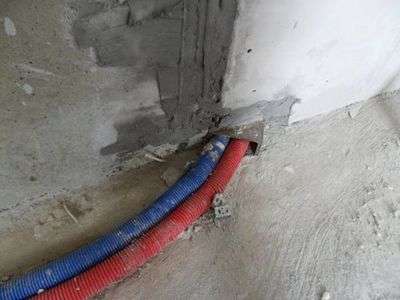

Efficiency. Do not be afraid that all the heat will go into the partition. Heating elements in such structures are designed for high power, which is enough for high-quality heating of the room. In addition, to increase the efficiency of the system, constructions with verified diameters are used and the most suitable wiring diagram is applied.
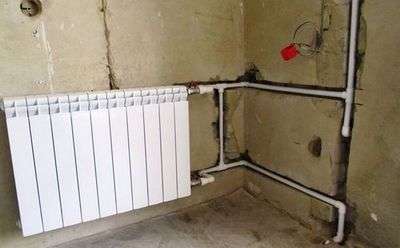

However, heating pipes in the wall also have disadvantages:
- In some cases, low power. The capacity of the system is highly dependent on the service provider. Sometimes there is not enough heat from the heating elements;
- Difficulties with the repair work. In the event of an emergency, it will be difficult to get to the structure. However, such contingencies are very rare;


Partition problems
If you want to drill a partition, you need to do this with great care so as not to hurt the structure. To do this, first of all, you need to study the wiring diagram in your house; Difficulties with carrying out cosmetic repairs in the apartment
Hot structures can cause the plaster to crack. Wallpaper may also come off.
It is difficult to say for sure how effective and convenient heating pipes in the wall will be. It all depends on the personal preference of the person. Some want to bring the heating pipes inside the room, while others, on the contrary, want to wed them into the wall. But, in any case, it should be remembered that work with risers must first be discussed with the relevant services. Unauthorized interference in the design scheme can entail a considerable fine.
Pipes will never add sophistication to a design
Even the most sophisticated design can easily ruin open heating pipes on the walls. They disharmonize on their own, and if the highways also intersect, then the room becomes like a utility room or technical room. You can avoid this situation if you think about how to hide the heating pipes from outside view in time.
What are the heating systems of an apartment building - schemes
The heating systems of most multi-storey buildings in our country, as a rule, are connected to a CHP or a central boiler house, that is, they are centralized. Depending on how the water circuits are mounted in the heating system of an apartment building, it can be either one-pipe or two-pipe.
Let's take a closer look at what heating systems exist for multi-storey buildings, and what are their advantages and disadvantages.
Centralized heating systems
First of all, it is worth mentioning the local or autonomous heating system. The advantage of this system is that it operates from a boiler room located inside the apartment building itself, or next to it. This allows you to independently regulate the temperature of the coolant.
The disadvantages of autonomy include its high price, because of which it is extremely rarely used in multi-storey buildings (basically, this system is chosen by the owners of private houses).
Much more often they build a CHP or arrange one powerful boiler house to heat an entire residential area. In this case, the coolant flows through the main pipes from the center to the heating points, and from there to the apartments. This principle of supply is called independent, since it allows you to additionally regulate the supply of the coolant using circulation pumps.


In the dependent heating system of a residential apartment building, the coolant is supplied to the apartment radiators directly from the CHP or boiler house. However, there is no significant difference between these two systems, since heat points perform here a function comparable to that performed by additional circulation pumps in an autonomous heating system, and do not affect the temperature of the coolant itself.
Also, the heating systems of an apartment building are divided into closed and open (you can familiarize yourself with the options for schemes on the Internet).
In a closed system, the heat carrier from the CHPP or boiler room enters the distribution point, from where it is separately supplied to the hot water supply and to the apartment radiators.
In an open system, such distribution is not provided, that is, it does not allow providing residents of the house with hot water outside the heating season.
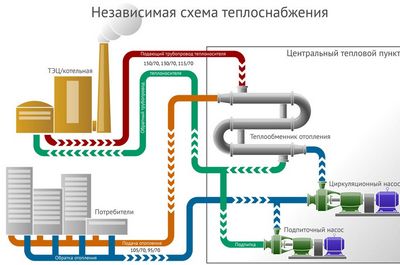

Connection types
As mentioned above, according to the type of connection, the systems of an apartment building are single-pipe and two-pipe.
The single-pipe heating system of an apartment building has a huge number of disadvantages, the most significant of which is considered to be a large heat loss along the way. In such a heating system of an apartment building, the scheme of which is simple, the coolant is supplied from the bottom up. Getting into the apartment radiators of the lower floors, and giving off heat, the water returns to the same pipe and, being fairly cooled, continues its way up. Hence the frequent complaints of residents of the upper floors that the radiators in their apartments do not warm up well.
The two-pipe heating system in the apartment (the diagram can be viewed on the Internet) is most widely used in construction. The main distinguishing feature of such a system is the presence of two highways: supply and return.
Through one pipe (supply), the heat carrier is transported from the heating boiler to the heating devices. The second line (return) is necessary to remove already chilled water and return it back to the boiler room.
The main plus of the two-pipe heating system of an apartment building is that the coolant is supplied to all heating devices evenly with the same temperature, regardless of whether the apartment is located on the first floor or on the sixteenth.
It is also important that the presence of two pipes greatly simplifies the process of flushing the heating systems of an apartment building.
There are two ways to arrange pipes, combined into a single heating network: horizontal and vertical.
A horizontal heating network, implying constant circulation of the coolant, is usually installed in low-rise buildings that have a long length (for example, in production workshops or in warehouses), as well as in panel-frame houses.
The vertical two-pipe heating system of an apartment building is used in multi-storey buildings, where each floor is connected separately. The indisputable advantage of such a network is that it practically does not form air jams.


Two-pipe heating network and types of wiring
Both pipe layouts (both vertical and horizontal) allow you to use two types of routing - lower and upper.At the same time, in the heating systems of multi-storey buildings, where the pipes are arranged in a vertical pattern, the lower wiring is usually used.
What is the difference between the bottom wiring and the top one?
When installing the lower wiring, the supply line is laid in the basement or basement, and the return line (the so-called "return") is even lower.
An upper air line device is required to vent excess air when using bottom routing. For an even distribution of the coolant throughout the system, it is recommended to place the boiler as low as possible in relation to the heating radiators.
The upper wiring is most often done in the attic, which must be well insulated. With this method of wiring, an expansion tank is installed at the highest point of the heating system. The main advantage of the upper distribution is the high pressure in the supply lines.
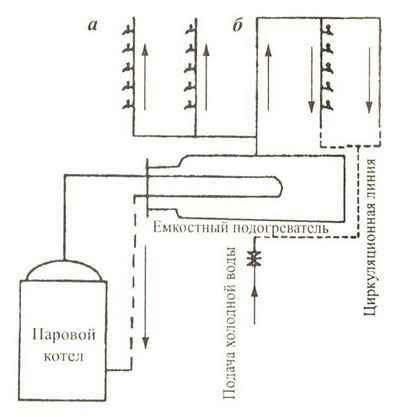

Recommend this material from WikiTEPLO to your friends on social networks, click on the link:
Methods for installing heating in the walls of the room
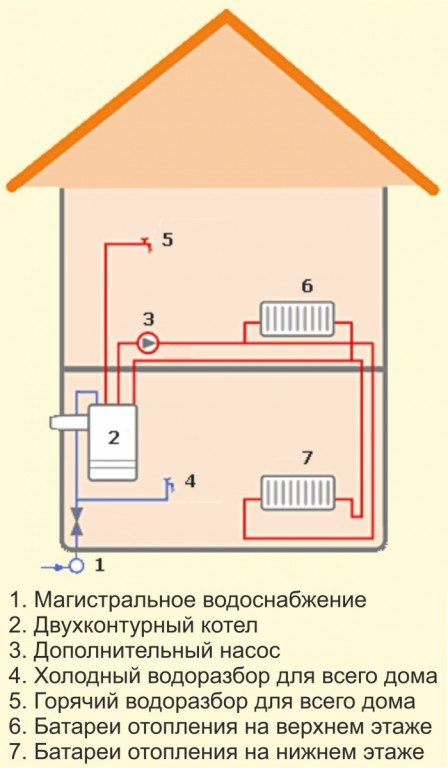

Direct piping scheme for a double-circuit gas boiler.
- Wall-mounted piping circuits or warm water walls are connected to a common hydraulic heating system for the entire apartment or house.
- Cable heating systems are used as an addition to the main heating system, electrical or cable. They represent a heating cable that is attached to the wall in the form of mats or along a certain path, has an autonomous connection to the network.
- Warm infrared walls are rod or film mats that are attached to the wall and connected in parallel. Typically, such heating in the wall is used as additional to the main heating system.
Where is the best place to locate a wall heating system:
- on the coldest wall of a room or in a corner room;
- the space in the room in front of such a system should not be cluttered with furniture or hung with carpets.
Wall systems are operated in a temperature regime not higher than 35-40 degrees, it is this temperature level that is considered the most comfortable for the human body. To maintain this optimum temperature, additional wall insulation is required to keep heat loss from the room to a minimum.
Installation of heating equipment using plaster coating:
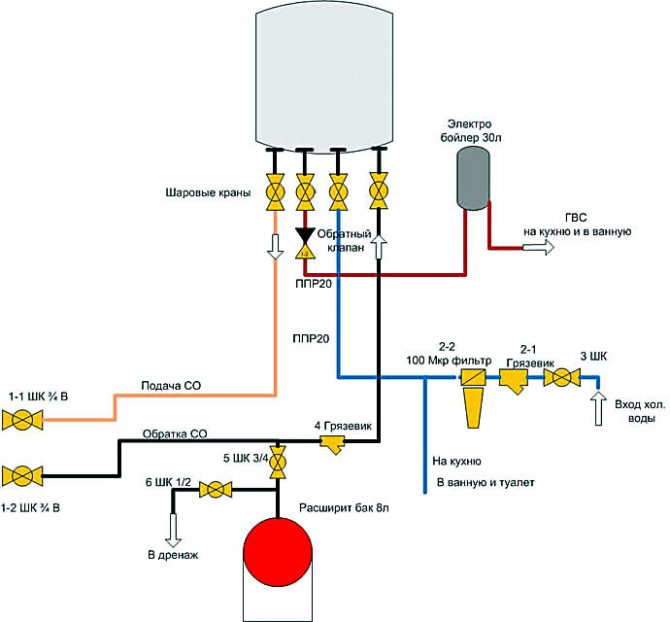

Scheme of piping a double-circuit boiler with a storage boiler.
- To do this, you need to prepare the wall, clean it, place the wiring and electrical boxes.
- Install the heat mixing unit.
- Glue polystyrene foam plates on the wall, and on top of them make a vapor barrier or apply foil insulation (for example, penofol).
- Fasten the mounting rails to the wall to accommodate the piping. If warm walls are installed in the bathroom, then the heating system can be brought outside the wall surface and used as a heated towel rail.
- Place a serpentine pipeline along the wall, bypassing those areas where the furniture will stand.
- Connect the pipes to the heat mixing unit through the manifolds.
- Press pipes 1.5 times more than the working pressure.
- Fasten the reinforcing mesh.
- Cover the wall with a thin layer of gypsum plaster.
- Fix the temperature sensor under the top layer of plaster.
- As soon as the first layer of plaster is dry, apply the second one immediately. So that the layer does not crack and does not interfere with heat transfer, the second layer is made of lime-cement and above the pipes its thickness reaches 3 cm.
- To avoid the formation of cracks during heating, reinforcement in the form of a thin mesh should be made over the plaster under the putty.
Installation of heating equipment using a bezel:
- Attach a heat-insulating material to the cleaned wall - foamed foamed foam or expanded polystyrene.
- For the installation of pipes, reinforce the tires.
- Place the pipeline along the wall, connect it to the manifold cabinet.
- Install a metal frame or already assembled from bars.
- Finally, attach prepared boards or panels made of plasterboard, plastic or fiberboard to the frame.
Panel heating systems
In panel heating systems, heating devices are steel pipes through which the coolant passes; the pipes are embedded in concrete panels. By combining elements of heating systems with building structures, the prefabrication of construction increased and labor costs were reduced. In addition, the sanitary-hygienic and aesthetic qualities have increased, as well as the metal consumption has decreased in comparison with heating systems in which radiators are the heating devices.
Fig. 1. Sill concrete heating panels: 1 - slab, 2 - coil, 3 - double adjustment tap, 4 - hatch, 5 - groove, 6 - heating riser, 7 - seams around the perimeter of the panel, 8 - sleeve, 9 - slag layer, 10 - floor, 11 - floor slab
When installing a panel heating, the heating element is placed: in attached window-sill panels, partitions, external walls, and also embedded in the ceiling or in the floor.
Heating panels are a complete prefabricated element, and their installation is carried out simultaneously with the construction of the building.
The window sill panel (Fig. 1) is a slab of concrete grade 200-250, into which a coil of pipes with a diameter of 20 mm is embedded. For thermal insulation of the panel from the outer wall, an insulating layer of slag wool with a thickness of 30-40 mm is laid between the panel wall and the outer wall. It is possible not to use an insulating layer, but in this case it is necessary to leave an air gap of 40-50 mm between the inner surface of the panel and the outer wall.
The panels are installed directly on the floor slab and attached to the outer wall.
Under-window heating panels are not widely used due to the complexity of their installation, as well as the need for additional laying of risers and connections.
Partition heating panels are used much more widely (Fig. 2). In these panels, not only heating elements, but also risers are monolithic, therefore, the installation of the system is reduced to installing the panels, connecting them with interfloor inserts and laying main pipelines.
The partition panel is a concrete slab 120 mm thick, 800-1000 mm wide and one floor high. The panel is part of the partition and is installed near the outer wall.
Fig. 2. Partition heating panels: a - for a two-pipe system, b - for a one-pipe system; 1 - heating elements, 2 - concrete panel, 3 - control valve
Partition heating panels can be used in two-pipe and one-pipe heating systems.
The disadvantages of partition panels are: equal heat transfer to two adjacent rooms with different heat losses and the inability to adjust the heat supply to each room, the difficulty of processing the interface between the panels and partitions (cracks), the absence of taps for household adjustment and a large concentrated heat transfer of the panel.
To reduce the concentrated heat transfer, heating elements are placed along the perimeter of the partition (Fig. 3).
Fig. 3. Partition concrete heating panels: a - riser diagram of a single-pipe panel heating system, b - partition heating panel of R-2 type, c - the same, R-4, d - the same, R-1, e - the same, R -3
Currently, the most rational are panel heating systems, in which heating elements and risers are embedded in external wall panels (Fig. 4).
In such systems, the number of cold surfaces in the room is reduced, and when the heater is located in the lower part of the outer wall under the windows, the effect of falling cold air flows from the windows is eliminated and the possibility of room-by-room temperature control is provided.
Fig. four.Wall panel with heating element
Heating panels are tested at the factory with a hydraulic pressure of 10 kgf / cm2. The panel is considered suitable for installation if no pressure drop is observed within 5 minutes.
For construction, panels are supplied with caps at the ends of the pipes to avoid blockages of the heating elements.
On construction sites, before installing the panel, heating elements are blown with air to remove scale and debris from them.
The concept of panel and electric heating
Fig. 5. Elevator
Panel heating system. In this case, pipes are sealed into the structure of the floor, ceiling or walls and a hot coolant is passed through them. The heat from the coolant to the air of the premises will be transferred by the surface of the building structure itself. Panel heating systems provide savings in metal, provide the best sanitary conditions for the air environment, and cause convective currents of minimum speed. The aforementioned advantages of panel heating and the emerging trend of building from large-sized elements make panel heating more and more popular in the construction of trade and public catering buildings.
Electric heating. The principle of operation of electric heating is that an electric current, passing through a conductor, heats it, and the latter heats the air around it. The most common among electric heating devices are reflectors. Electric heating does not require the preparation of fuel, its heating devices are lightweight, the possibility of freezing of devices is excluded. However, this type of heating is fire hazardous and consumes a significant amount of electricity. In view of these shortcomings, electric heating has not become widespread and is used in trade and public catering buildings located in areas with a short heating period, as a temporary heating device.
Panel heating systems
In modern housing and civil construction, panel heating systems are widely used. A distinctive feature of them is that part of the surface of any room fence, which is a heating panel heated by some kind of coolant, gives off heat to the rest of the fences and the air of the heated room. At the same time, from the point of view of the thermal effect, it makes no difference where the panel is located - in the ceiling, in the floor or in the wall.
Heating panels are mostly made of concrete. Mainly water is used as a heat carrier, as well as steam and air. With water and steam heat carriers, the heating elements of the panels are coils or registers made of water-gas supply electric-welded or seamless pipes. With ceiling panels, heat transfer is mainly carried out by radiation; convection is only an accompanying factor here. In the case of placing heating panels in walls, the role of radiation decreases as the radiating surfaces approach from the ceiling to the floor. In systems with floor panels, convection prevails over radiation. In all cases, the radiant component of heat transfer from panel heating systems is much higher than conventional radiator ones, in which heat transfer is carried out mainly by convection. Therefore, unlike radiator (convection) heating, panel heating is sometimes called radiant. Parts of panel heating systems in walls and ceilings (ceiling and floor).
Wall decoration behind the radiators. Think about the little things
It turns out that when people make repairs in their apartments, they completely forget that the decoration of the walls behind the radiators is just as important as the decoration of the main walls. And after finishing the work, they realize that the batteries, in fact, are not completed, the wall behind them is ugly, and of course it needs to be brought into the appropriate form.
Why is this happening? Here are some reasons:
- the heating battery covers a part of the wall, so there is no need to do something behind it;
- there will be long curtains from the eaves to the floor and the batteries will not be visible at all;
- decorative screens will be hung on the batteries.
It is difficult to disagree with these points, since they are absolutely fair. But, not every family is able to plan all future repairs, as they say, on a turnkey basis, and many little things are thought out along the way. For example, after the completion of the repair, it turns out:
- probably in this room with such wallpaper, blinds are better, or short curtains to the windowsill, and not to the floor;
- the room is relatively small in area, and if you hang decorative screens on batteries, they will look very cumbersome and steal space in the room.
So it turns out that the primary vision regarding batteries has changed. It turns out that there will be no long curtains or decorative screens. So what then? A terrible untreated wall behind the radiators, which is very visible in the absence of curtains? By the way, there are houses where there are 2 windows in the rooms. So 2 scary walls will be visible?
What is the difficulty, you ask? Just think of a small piece of a wall, it can be done in a couple of days. However, this is an erroneous, at first glance, opinion. If the wall behind the batteries is really crooked or with potholes, then you can't just stick the wallpaper on it, most likely it will have to be leveled at the very least, which means you have to fiddle with the primer, and with plaster, and with putty. Read my detailed article about. After gluing the wallpaper, you must not forget to cut out and, which under the batteries are solid external and internal corners. The worst thing is that if your major repairs have already been completed, then the apartment is relatively clean. And just imagine, in a mini-version you actually have to repeat the entire repair from start to finish with a small piece of the wall.
True, I can reassure you a little, because there are certain assumptions that will still allow you to reduce the time. So let's get started. In parallel, I will take into account the time spent on such repairs.
Output
As we can see, there are quite a few options for plastering various surfaces. However, upon a detailed examination of the technology, it turns out that there is nothing super complicated in this.
For example, having figured out how to plaster OSB, even a novice builder can do this work, so there are no impossible tasks when decorating a house with plaster. Additional information on this topic can be obtained from the video in this article.
Very often, during construction work, heating pipes are hidden in the wall, advantages and disadvantages
This method of hiding pipes must be studied thoroughly to determine whether this method is suitable for you or not. Otherwise, not only the functioning of the heating may suffer, but also the design of the room.
It is better to carry out hidden laying of pipes during the construction phase. In an already functioning house, this issue is much more difficult to solve. If earlier communications were left fixed to the walls, then a significant advantage of high-quality modern repairs is that these options are not permissible.
How to maintain pipes in the wall
It is enough to observe the technology and sequence of work when placing the pipes of the heating system in the wall. It is important to choose high-quality materials and fasteners.
Before applying a plaster layer or installing a false wall, it is necessary to test the heating system under high pressure in operation for at least 1 week.
If the requirements are met, the structure can function for up to 50 years, depending on the manufacturer's guarantees for its materials.
It is also possible to decorate the section of the wall on which the disguised pipes are located with expensive materials.
The method of masking the heating system is quite popular, but it requires increased security measures during installation.Also, it is quite difficult to obtain permission to mask the heating system in an apartment building, since according to technical regulations, all communications must be open for free access in case of an emergency.
